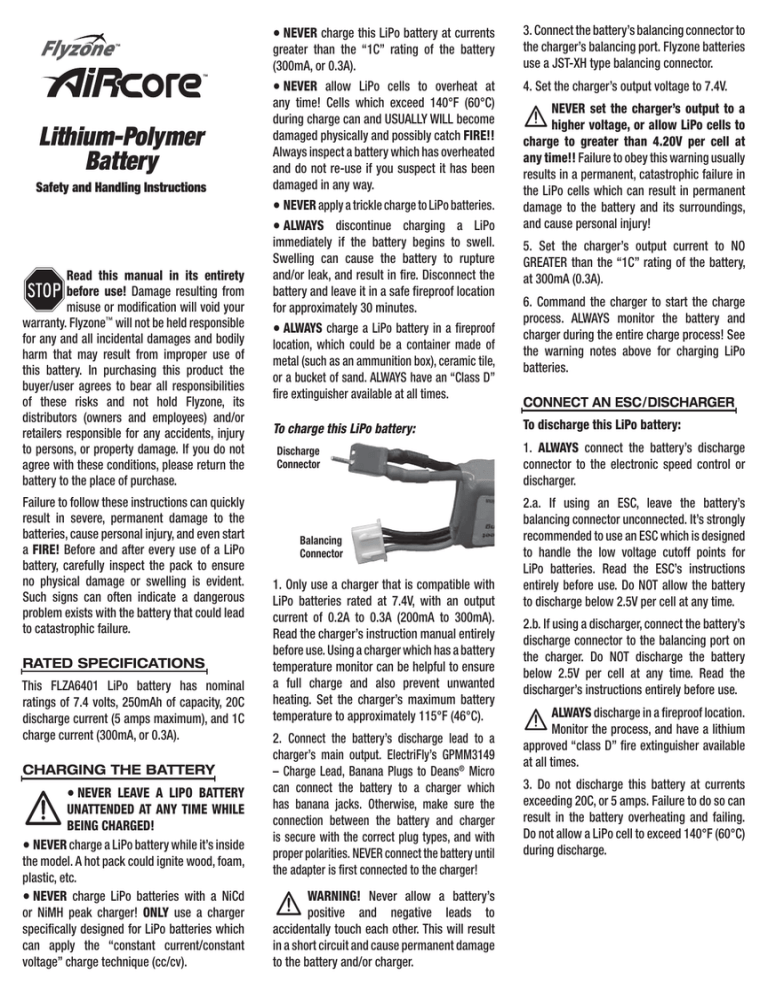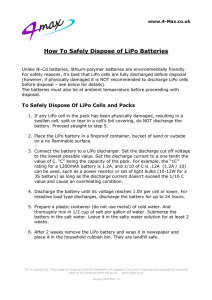
• NEVER charge this LiPo battery at currents
™
™
Lithium-Polymer
Battery
Safety and Handling Instructions
Read this manual in its entirety
before use! Damage resulting from
misuse or modification will void your
warranty. Flyzone™ will not be held responsible
for any and all incidental damages and bodily
harm that may result from improper use of
this battery. In purchasing this product the
buyer/user agrees to bear all responsibilities
of these risks and not hold Flyzone, its
distributors (owners and employees) and/or
retailers responsible for any accidents, injury
to persons, or property damage. If you do not
agree with these conditions, please return the
battery to the place of purchase.
Failure to follow these instructions can quickly
result in severe, permanent damage to the
batteries, cause personal injury, and even start
a FIRE! Before and after every use of a LiPo
battery, carefully inspect the pack to ensure
no physical damage or swelling is evident.
Such signs can often indicate a dangerous
problem exists with the battery that could lead
to catastrophic failure.
RATED SPECIFICATIONS
This FLZA6401 LiPo battery has nominal
ratings of 7.4 volts, 250mAh of capacity, 20C
discharge current (5 amps maximum), and 1C
charge current (300mA, or 0.3A).
CHARGING THE BATTERY
• NEVER LEAVE A LIPO BATTERY
UNATTENDED AT ANY TIME WHILE
BEING CHARGED!
• NEVER charge a LiPo battery while it’s inside
the model. A hot pack could ignite wood, foam,
plastic, etc.
• NEVER charge LiPo batteries with a NiCd
or NiMH peak charger! ONLY use a charger
specifically designed for LiPo batteries which
can apply the “constant current/constant
voltage” charge technique (cc/cv).
greater than the “1C” rating of the battery
(300mA, or 0.3A).
• NEVER allow LiPo cells to overheat at
any time! Cells which exceed 140°F (60°C)
during charge can and USUALLY WILL become
damaged physically and possibly catch FIRE!!
Always inspect a battery which has overheated
and do not re-use if you suspect it has been
damaged in any way.
• NEVER apply a trickle charge to LiPo batteries.
• ALWAYS discontinue charging a LiPo
immediately if the battery begins to swell.
Swelling can cause the battery to rupture
and/or leak, and result in fire. Disconnect the
battery and leave it in a safe fireproof location
for approximately 30 minutes.
• ALWAYS charge a LiPo battery in a fireproof
location, which could be a container made of
metal (such as an ammunition box), ceramic tile,
or a bucket of sand. ALWAYS have an “Class D”
fire extinguisher available at all times.
To charge this LiPo battery:
Discharge
Connector
Balancing
Connector
1. Only use a charger that is compatible with
LiPo batteries rated at 7.4V, with an output
current of 0.2A to 0.3A (200mA to 300mA).
Read the charger’s instruction manual entirely
before use. Using a charger which has a battery
temperature monitor can be helpful to ensure
a full charge and also prevent unwanted
heating. Set the charger’s maximum battery
temperature to approximately 115°F (46°C).
2. Connect the battery’s discharge lead to a
charger’s main output. ElectriFly’s GPMM3149
– Charge Lead, Banana Plugs to Deans® Micro
can connect the battery to a charger which
has banana jacks. Otherwise, make sure the
connection between the battery and charger
is secure with the correct plug types, and with
proper polarities. NEVER connect the battery until
the adapter is first connected to the charger!
WARNING! Never allow a battery’s
positive and negative leads to
accidentally touch each other. This will result
in a short circuit and cause permanent damage
to the battery and/or charger.
3. Connect the battery’s balancing connector to
the charger’s balancing port. Flyzone batteries
use a JST-XH type balancing connector.
4. Set the charger’s output voltage to 7.4V.
NEVER set the charger’s output to a
higher voltage, or allow LiPo cells to
charge to greater than 4.20V per cell at
any time!! Failure to obey this warning usually
results in a permanent, catastrophic failure in
the LiPo cells which can result in permanent
damage to the battery and its surroundings,
and cause personal injury!
5. Set the charger’s output current to NO
GREATER than the “1C” rating of the battery,
at 300mA (0.3A).
6. Command the charger to start the charge
process. ALWAYS monitor the battery and
charger during the entire charge process! See
the warning notes above for charging LiPo
batteries.
CONNECT AN ESC/DISCHARGER
To discharge this LiPo battery:
1. ALWAYS connect the battery’s discharge
connector to the electronic speed control or
discharger.
2.a. If using an ESC, leave the battery’s
balancing connector unconnected. It’s strongly
recommended to use an ESC which is designed
to handle the low voltage cutoff points for
LiPo batteries. Read the ESC’s instructions
entirely before use. Do NOT allow the battery
to discharge below 2.5V per cell at any time.
2.b. If using a discharger, connect the battery’s
discharge connector to the balancing port on
the charger. Do NOT discharge the battery
below 2.5V per cell at any time. Read the
discharger’s instructions entirely before use.
ALWAYS discharge in a fireproof location.
Monitor the process, and have a lithium
approved “class D” fire extinguisher available
at all times.
3. Do not discharge this battery at currents
exceeding 20C, or 5 amps. Failure to do so can
result in the battery overheating and failing.
Do not allow a LiPo cell to exceed 140°F (60°C)
during discharge.
BATTERIES INVOLVED IN A CRASH
STORAGE & TRANSPORTATION
LiPo batteries involved in a crash can be
dangerous. Even if no physical damage is
visible, a delayed chemical reaction could cause
the battery to ignite even after having been
removed from the crash for some time. After a
crash, place the battery in a fireproof location
IF SAFE TO DO SO, and observe for at least 30
minutes. Carefully inspect it for cracks, splits,
punctures, etc. Do not continue to use damaged
batteries. Refer to the DISPOSAL OF LIPO
BATTERIES section at the end of this manual.
• For long term storage, it’s recommended to
CAUTION! Cells may be hot! DO NOT allow
the battery’s internal electrolyte to get in
the eyes or on skin. Wash affected areas with
soap and water immediately if they come in
contact with the electrolyte. If electrolyte makes
contact with the eyes flush with large amounts
of water for 15 minutes and seek medical
attention immediately. If a battery leaks
electrolyte or gas vapors, do not inhale leaked
material. Leave the area and allow the batteries
to cool and the vapors to dissipate. Remove
spilled liquid with absorbent and dispose.
SAFETY PRECAUTIONS
• NEVER allow LiPo batteries to be charged or
discharged on or near combustible materials,
including paper, plastic, carpets, vinyl, leather,
wood, inside an R/C model or full-sized
automobile.
• NEVER put packs in the pocket of any clothing.
• NEVER allow LiPo cells to come in contact
with moisture or water at any time.
• NEVER store batteries near an open flame
or heater.
• NEVER assemble LiPo cells or pre-assembled
packs together with other LiPo cells/packs.
Only a qualified battery assembly company
should assemble or modify LiPo batteries.
• NEVER allow LiPo cells to become
punctured, especially by metallic objects such
as screwdrivers, T-pins, or hobby knives.
• ALWAYS provide adequate ventilation
around LiPo batteries during charge, discharge,
and during storage. If a battery becomes
overheated IMMEDIATELY place it in a fireproof location until it cools.
• ALWAYS store LiPo cells/packs in a secure
location away from children.
• ALWAYS make sure that metallic objects, such
as wristwatches, bracelets, or rings are removed
from your hands when handling LiPo packs.
Accidentally touching battery terminals to any
such objects could create a short-circuit condition
and possibly cause severe personal injury.
charge the cells fully, then discharge them to a
50-60% of their rated capacity.
• Store battery at room temperature in a
cool or shaded area, ideally between 40-80ºF.
Temperatures exceeding 170ºF for greater
than 1 hour may cause damage to the battery
and cause a fire.
• Do not expose battery packs to direct
sunlight for extended periods of time, or place
in a direct contact with any liquids. If batteries
come in contact with water, immediately dry
the battery with a clean towel.
• When transporting LiPo batteries, store them
in a fireproof container. NEVER leave batteries
lying loosely anywhere in the car (in the trunk,
backseat, floor, etc.).
5. Disconnect the battery, and submerse it
into bucket or tub of salt water. This container
should have a lid, but it does not need to be
air-tight. Prepare a bucket or tub containing 3
to 5 gallons of cold water, and mix in 1/2 cup of
salt per gallon of water. Drop the battery into
the salt water. Allow the battery to remain in
the tub of salt water for at least 2 weeks.
6. Remove the LiPo battery from the salt water
and place it in the normal trash.
Hobby Services
3002 N. Apollo Drive,
Suite 1,
Champaign, IL 61822
(217) 398-0007
hobbyservices@hobbico.com
www.flylzoneplanes.com
• ALWAYS make sure all plugs / connectors
on the LiPo battery are covered, to prevent an
accidental short. Small sections of fuel tubing
make good insulators.
• NEVER leave LiPo batteries in the car
indefinitely as temperatures inside the vehicle
can easily rise far in excess of 120ºF which
could damage the battery.
DISPOSAL OF LIPO BATTERIES
Lithium-polymer batteries are environmentally
friendly. For safety reasons LiPo cells should
be fully discharged before disposal (however, if
physically damaged it is NOT recommended to
discharge LiPo cells before disposal - see below
for details). The batteries must also be cool
before proceeding with disposal instructions.
To dispose of LiPo cells and packs:
1. Place the LiPo battery in a fireproof
container or bucket of sand.
2. If any LiPo cell in the pack has been
physically damaged, resulting in a swollen cell
or a split or tear in a cell’s foil covering, do NOT
discharge the battery. Jump to step 5.
3. Connect the battery to a LiPo discharger.
Set the discharge cutoff voltage to the
lowest possible value, and the current as
low as 20mA if possible. It’s also possible to
discharge the battery by connecting it to an
ESC/motor system and allowing the motor
to run indefinitely until no power remains to
further cause the system to function.
4. Discharge the battery until its voltage
reaches 1.0V per cell or lower.
FLZA6401INSTR
© 2013 Hobbico, Inc. All rights reserved.



